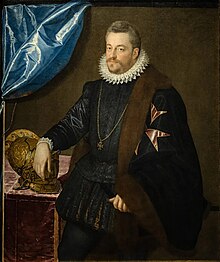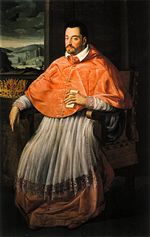Ferdinando I de' Medici
This article needs additional citations for verification. (July 2018) |
| Ferdinando I | |||||
|---|---|---|---|---|---|
 Ferdinando in 1590 | |||||
| Grand Duke of Tuscany | |||||
| Reign | 19 October 1587 – 7 February 1609 | ||||
| Predecessor | Francesco I | ||||
| Successor | Cosimo II | ||||
| Born | 30 July 1549 Florence, Duchy of Florence | ||||
| Died | 3 February 1609 (aged 59) Florence, Grand Duchy of Tuscany | ||||
| Spouse | Christina of Lorraine | ||||
| Issue | |||||
| |||||
| House | Medici | ||||
| Father | Cosimo I de' Medici, Grand Duke of Tuscany | ||||
| Mother | Eleanor of Toledo | ||||
Ferdinando I de' Medici, Grand Duke of Tuscany (30 July 1549 – 3 February 1609) was Grand Duke of Tuscany from 1587 to 1609, having succeeded his older brother Francesco I.
Early life
[edit]

Ferdinando was the fifth son (the third surviving at the time of his birth) of Cosimo I de' Medici, Grand Duke of Tuscany, and Eleanor of Toledo, the daughter of Pedro Álvarez de Toledo, Marquis of Villafranca, the Spanish viceroy of the Kingdom of Naples.
He was made a Cardinal in 1562 at the age of 13, but was never ordained into the priesthood. At Rome, he proved an able administrator. He founded the Villa Medici in Rome. He acquired the large collection of antiquities established by Andrea della Valle in 1584, as well as other works of art like the Medici lions. These were subsequently divided among the various Medici estates.
Grand Duke
[edit]When his brother Francesco I de' Medici, Grand Duke of Tuscany, died in 1587, Ferdinando succeeded as grand duke at the age of 38.[citation needed]
In many ways, Ferdinando was the opposite of his brother who preceded him. Approachable and generous, he set out to rule mildly. He re-established the justice system and was genuinely concerned about the welfare of his subjects. During his reign, Tuscany revived and regained the independence his brother had given up.
Ferdinando fostered commerce and gained great wealth through the Medici banks, which were established in all the major cities of Europe. He enacted an edict of tolerance for Jews and non-Catholics,[1] and Livorno became a haven for Spanish Jews as well as other persecuted foreigners. He established the Medici Oriental Press (Typographia Medicea), which published numerous books in the Arabic script.
He improved the harbour Cosimo I had built and diverted part of the flow of the Arno river into a canal called the Naviglio, which aided commerce between Florence and Pisa. He fostered an irrigation project in the Val di Chiana, which allowed the flatlands around Pisa and Fucecchio and in the Val di Nievole to be cultivated.
The greatest cultural achievement in Florence during Ferdinando's reign was the introduction of opera to Europe. For the wedding of Ferdinando's niece Marie de' Medici to King Henry IV of France in 1600, his court sponsored a lavish performance of one of the first notable operas, Jacopo Peri's Euridice.[citation needed]
Marriage
[edit]For the first two years of his reign, he retained his position as cardinal, but he gave it up in order to marry Christina of Lorraine in 1589.[2] The couple had a large reception at the Villa di Poggio a Caiano. Christina's dowry was fairly large; it included 600,000 crowns in cash as well as jewellery with a value of 50,000 crowns. Also, the rights of the Duchy of Urbino were transferred to Christina after the death of Queen Catherine de' Medici of France and thus assumed by future Medici rulers.[3]
Foreign policy
[edit]
Ferdinando's foreign policy attempted to free Tuscany from Spanish domination. After the assassination of Henry III of France in 1589, he supported Henry IV of France in his struggles against the Catholic League. Ferdinando lent Henry money and encouraged him to convert to Catholicism, which he eventually did. Ferdinando also used his influence with Pope Clement VIII to get him to accept Henry's conversion.[citation needed]
Henry showed no appreciation for these favours, and Ferdinando let the relationship cool, maintaining his cherished independence. He supported Philip III of Spain in his campaign in Algeria and Rudolf II, Holy Roman Emperor in his against the Ottoman Empire. For these undertakings, he found it necessary to raise taxes on his subjects. He finally obtained the formal investiture of Siena, which his father had conquered.
Ferdinando strengthened the Tuscan fleet, and it saw victories against pirates on the Barbary coast in 1607 and against a superior Turkish fleet the following year.
He also dreamed of a small African empire, and then considered the possibility of a colony in Brazil.[4] A few months before his death, Ferdinando organised an expedition in 1608 under the command of Captain Robert Thornton to northern Brazil and the Amazon River in order to create a colony.
Issue
[edit]- Cosimo II (1590–1621), who succeeded as Grand Duke of Tuscany; he married Maria Maddalena of Austria and had issue
- Eleonora (1591–1617), died unmarried
- Caterina (1593–1629), married Ferdinando Gonzaga, Duke of Mantua, later Governor of Siena
- Francesco (1594–1614), died unmarried
- Carlo (1595–1666), died unmarried
- Filippino (1598–1602), died unmarried
- Lorenzo (1599–1648), died unmarried
- Maria Maddalena (1600–1633), died unmarried
- Claudia (1604–1648), married first to Federico della Rovere and had issue, then to Leopold V, Archduke of Austria, and had issue.
Ancestors
[edit]| Ancestors of Ferdinando I de' Medici | |||||||||||||||||||||||||||||||||||||||||||||||||||||||||||||||||||||||||||||||||||||||||||||||||||||||||||||||||||||||||||||||||||||||||||||||||||||||||||||||||||||||||||||||||||||||||||||||||||||||||||||||||||||||||||||||||||||||||||||||||||||||||||||||||||||||||||||||||||||||||
|---|---|---|---|---|---|---|---|---|---|---|---|---|---|---|---|---|---|---|---|---|---|---|---|---|---|---|---|---|---|---|---|---|---|---|---|---|---|---|---|---|---|---|---|---|---|---|---|---|---|---|---|---|---|---|---|---|---|---|---|---|---|---|---|---|---|---|---|---|---|---|---|---|---|---|---|---|---|---|---|---|---|---|---|---|---|---|---|---|---|---|---|---|---|---|---|---|---|---|---|---|---|---|---|---|---|---|---|---|---|---|---|---|---|---|---|---|---|---|---|---|---|---|---|---|---|---|---|---|---|---|---|---|---|---|---|---|---|---|---|---|---|---|---|---|---|---|---|---|---|---|---|---|---|---|---|---|---|---|---|---|---|---|---|---|---|---|---|---|---|---|---|---|---|---|---|---|---|---|---|---|---|---|---|---|---|---|---|---|---|---|---|---|---|---|---|---|---|---|---|---|---|---|---|---|---|---|---|---|---|---|---|---|---|---|---|---|---|---|---|---|---|---|---|---|---|---|---|---|---|---|---|---|---|---|---|---|---|---|---|---|---|---|---|---|---|---|---|---|---|---|---|---|---|---|---|---|---|---|---|---|---|---|---|---|---|---|---|---|---|---|---|---|---|---|---|---|---|---|---|---|---|
| |||||||||||||||||||||||||||||||||||||||||||||||||||||||||||||||||||||||||||||||||||||||||||||||||||||||||||||||||||||||||||||||||||||||||||||||||||||||||||||||||||||||||||||||||||||||||||||||||||||||||||||||||||||||||||||||||||||||||||||||||||||||||||||||||||||||||||||||||||||||||
References
[edit]- ^ Ferdinando I De Medici, Document Inviting Jewish Merchants to Settle in Livorno and Pisa, in Italian, Manuscript on Vellum, Florence, Italy, 10 June 1593 (fac-simile)
- ^ BBC Radio4
- ^ Strong. Roy, C. Art and power: Renaissance festivals, 1450-1650. p. 129.
- ^ "Italians in Brasil, of Matteo Sanfilippo (in Italian)". Archived from the original on 20 July 2011. Retrieved 9 March 2010.
- Hibbert, Christopher (1979). "XXI". In Pelican History of Art (ed.). The Rise and Fall of the House of Medici. Penguin Books Ltd. pp. 279–281.
External links
[edit] Media related to Ferdinando I, Grand Duke of Tuscany at Wikimedia Commons
Media related to Ferdinando I, Grand Duke of Tuscany at Wikimedia Commons- Works by Ferdinando I de' Medici at Project Gutenberg
- Works by or about Ferdinando I de' Medici at the Internet Archive
- Works by or about Grand Duke of Tuscany at the Internet Archive

